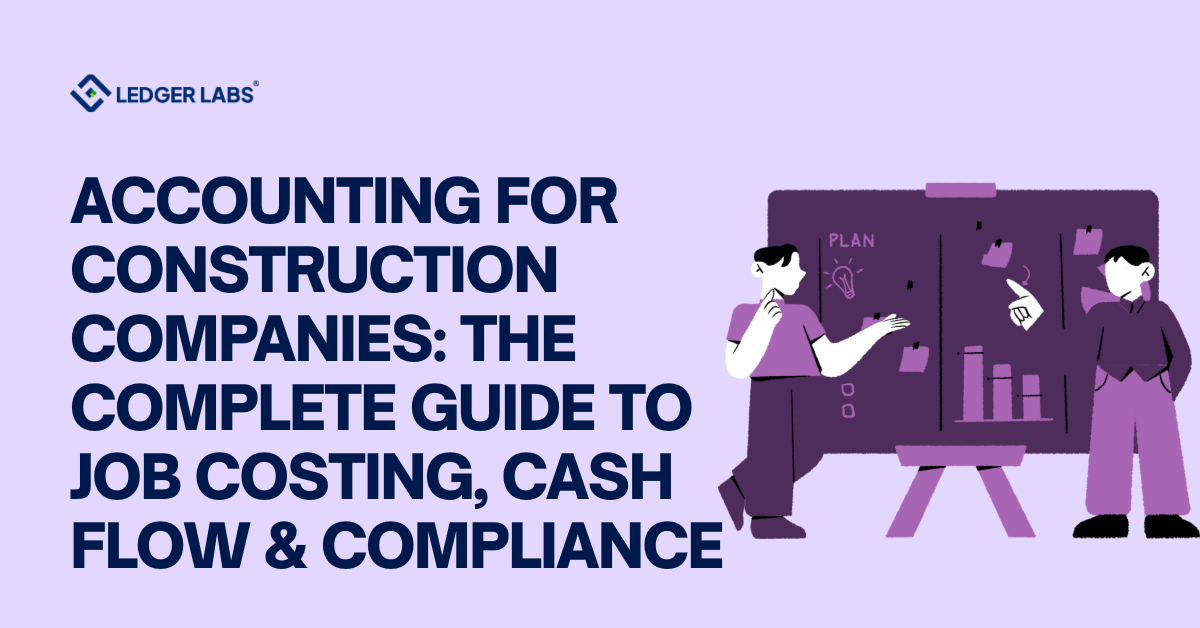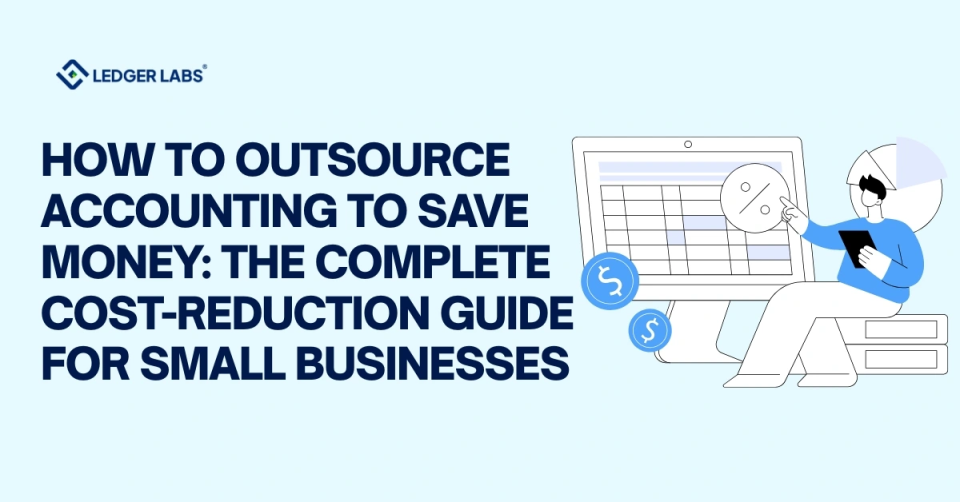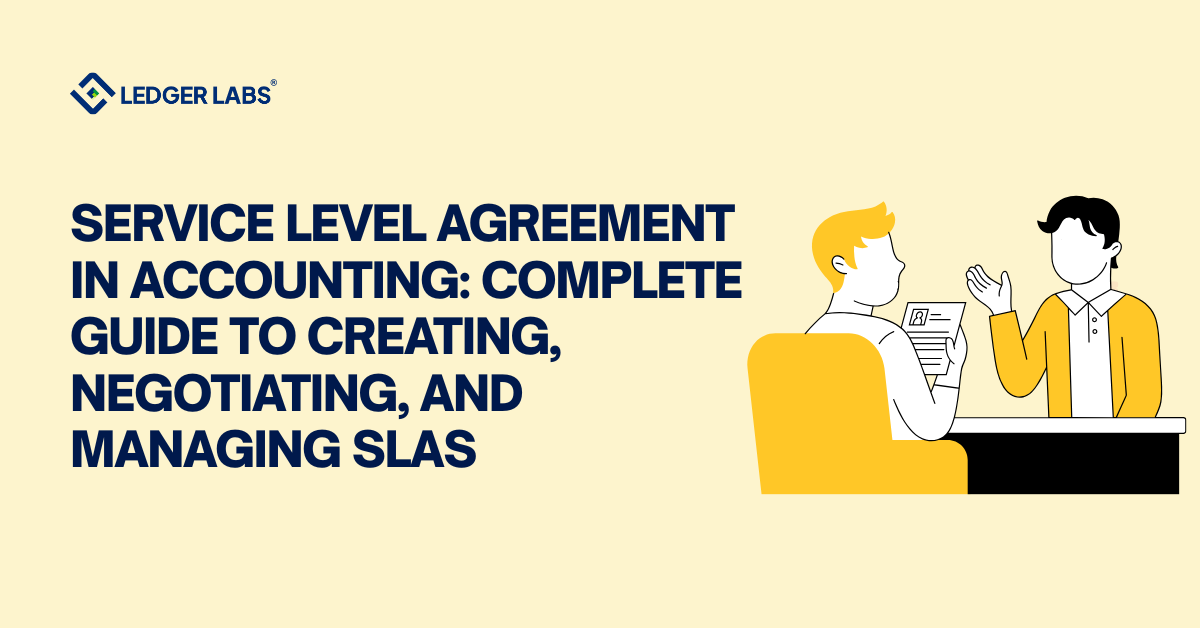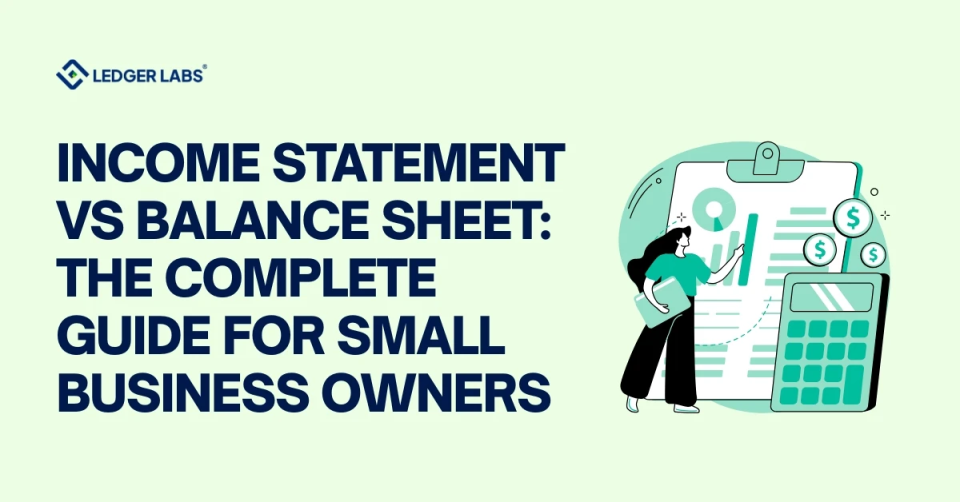Your P&L says you made $80,000 on that last project, but when payroll hits, the cash isn’t there. That gap between “profitable on paper” and “money in the bank” is exactly what proper accounting for construction companies is designed to close.
According to a 2023 CFMA survey, 76% of contractors using industry-specific accounting systems reported improved project profitability versus just 34% using general software. The difference?
Construction accounting tracks finances by job, not just by month, so you actually know which projects make money before it’s too late.
In this guide, we’ll walk through job costing, revenue recognition, billing methods, and the outsourcing decision so you can take control of your numbers.
Key Takeaways
- Construction accounting is project-based, tracking costs by job, phase, and cost code, not by department or product line, as in standard bookkeeping.
- Job costing assigns every expense (labor, materials, equipment, overhead) to specific projects, allowing you to catch cost overruns early and improve bid accuracy.
- Revenue recognition methods (cash, accrual, percentage-of-completion, completed-contract) impact taxes and financial statements. Contractors with long-term contracts over $25 million must use the percentage-of-completion method.
- Retainage (5-10% withheld per invoice) combined with progress billing cycles creates cash flow gaps that require deliberate planning and dedicated tracking accounts.
- Construction payroll involves prevailing wage compliance (Davis-Bacon), union reporting, multi-state taxation, and certified payroll, requirements that general payroll systems can’t handle.
- Outsourcing construction accounting costs $18,000- $60,000/year, providing specialized expertise at a fraction of the cost of a full-time hire ($ 65,000–$95,000+), making it ideal for contractors with revenue under $ 10 M.
What Makes Construction Company Bookkeeping Different From Standard Accounting?
Construction accounting is project-based and decentralized, requiring the tracking of fluctuating costs for labor, materials, and equipment on each job site. Unlike standard accounting systems that focus on single-location product sales with predictable costs, construction involves multiple projects with distinct budgets, timelines, and payment schedules. Costs can change daily due to factors like weather, change orders, and material prices.
Standard bookkeeping tracks revenue when you send an invoice. Construction company bookkeeping tracks revenue when you’ve actually earned it, which might be 30% through a 14-month project.
You’re also dealing with retainage (money held back until project completion), progress billing tied to milestones, and subcontractor payments that flow through your books before hitting the bank.
Key Differences at a Glance
| Factor | Standard Accounting | Construction Accounting |
|---|---|---|
| Revenue Model | Product/service sales | Project-based contracts |
| Production Location | Fixed facility | Multiple job sites |
| Payment Terms | Net 30–60 typical | Progress billing + retainage |
| Cost Tracking | By department or product | By job, phase, and cost code |
| Cash Flow Cycle | Predictable | Irregular, project-dependent |
Accounting for contractors requires special knowledge. A general bookkeeper might keep your records organized, but could overlook that your largest project is losing money.
How Does Job Costing Work in Construction?
Job costing assigns every expense, such as labor, materials, equipment, and overhead, to a specific project and cost code. This lets you compare actual costs against estimates, identify profitable vs. unprofitable jobs, and build more accurate bids.
Picture this: You placed a bid of $150,000 on a commercial remodel, expecting to make a 15% profit. Six months later, the project wraps up. But did you really earn $22,500? Without job costing, you won’t find out until tax time if that profit was even real.
Job costing for construction provides that answer while work is still in progress. Every hour of labor, every load of materials, and every piece of equipment rental is tagged to the specific project and cost category where it belongs.
Step 1: Define and Set Up the Job
The first step is to define each project or job. Each job should be treated as a separate entity, with all associated costs tracked separately to calculate profitability accurately.
This involves:
- Creating a job cost sheet with the project name, location, and estimated costs
- Assigning a unique job number for tracking
- Establishing the project budget
Step 2: Establish Cost Categories and Cost Codes
Start by outlining all potential costs before work begins. Establish clear cost categories.
A strong cost code system, typically based on the industry-standard MasterFormat, provides the structure for organizing and categorizing project costs.
Primary cost categories include:
- Direct costs: Materials, labor, equipment, subcontractors
- Indirect costs: Project management, administrative costs
- Overhead: Insurance, office expenses, allocated operating costs
Step 3: Break Down Jobs into Phases
Each job is divided into phases, the major steps required to complete the project. These might include phases like site preparation, foundation laying, framing, and interior finishing.
This phase breakdown allows you to:
- Track costs at each project stage
- Identify which phases are over/under budget
- Compare phase costs across similar projects
Step 4: Track Costs in Real-Time
Job costing loses value if expenses are only logged at the end of the project. Enter costs as they happen (or aim to do it at least weekly) so reports stay accurate.
All costs incurred during a project are recorded and categorized. It includes the cost of materials, labor, equipment rentals, subcontractors, and overhead costs.
Step 5: Track Change Orders Immediately
Change orders can derail profitability if they’re not tracked. Any time scope shifts or extras are added, document the financial impact right away and update the job budget.
Step 6: Compare Budget vs. Actual (Measure)
This systematic approach allows for early detection of any deviations from the budget, facilitating prompt corrective action to keep project costs within the established cost parameters.
The measuring stage involves thoroughly comparing a job’s estimated costs against the actual costs incurred during construction. This step is not only about identifying variances but also about understanding the reasons behind them.
Step 7: Analyze, Report, and Improve
Treat job costing as an ongoing process. Hold regular reviews with project managers and accounting to identify issues like budget overruns or unexpected expenses. Use the insights gained from these reviews to improve future estimates and strategies.
For example, adjust bids to allocate more time and budget to tasks known to be more complex or time-consuming.
When job costing is done right, you can catch a cost overrun at week three instead of month six. According to the Construction Financial Management Association, contractors who track job costs in real-time experience 23% fewer budget overruns than those who review costs monthly.
The challenge? Accounting for general contractors means tracking dozens of cost codes across multiple active projects. That’s why most contractors either invest in construction-specific accounting software or outsource to specialists.
What Are the Main Revenue Recognition Methods for Contractors?
Contractors typically use one of four revenue recognition methods: cash-basis, accrual-basis, percentage-of-completion (PCM), or completed-contract (CCM). The right choice depends on your company size, contract duration, and IRS requirements.
Revenue recognition sounds technical, but the core question is simple: When do you count a dollar as earned?
If you bill a customer $50,000 for completing the foundation, but they won’t pay for 45 days, is that revenue now or later?
Your answer affects taxes, financial statements, and how lenders view your business.
| Revenue Recognition Methods Compared | |||
|---|---|---|---|
| Method | When Revenue Recognized | Best For | IRS Restrictions |
| Cash Basis | When payment is received | Small contractors (<$25M revenue) | Limited to qualifying small businesses |
| Accrual Basis | When billed or earned | Most businesses | Required for larger contractors |
| Percentage of Completion | As work progresses | Long-term contracts (2+ years) | Required for large contractors on long contracts |
| Completed Contract | When the project finishes | Home builders, short projects | Limited to qualifying contracts |
Important: Contractors with average gross receipts over $25 million must use the percentage-of-completion method for contracts lasting two or more years under IRS guidelines. Switching methods requires IRS approval and can trigger tax adjustments.
The percentage-of-completion method ties revenue to project progress. If you’re 40% through a $500,000 contract, you recognize $200,000 in revenue, regardless of billing. This method offers a clearer view of your business’s health.
Accurate revenue recognition impacts your financial statements, bonding capacity, and loan eligibility. A poor choice can lead to tax issues and misrepresent your financial position to banks and sureties.
How Do Retainage, Billing Methods, and Cash Flow Work Together?
Retainage withholds 5-10% of each payment until project completion. Combined with progress billing cycles and delayed payments, this creates cash flow gaps that require careful construction cash flow management to survive.
Here’s a scenario every contractor knows: You’ve completed $400,000 in work, billed $350,000, collected $280,000, and have $35,000 in retainage sitting untouchable until final sign-off. Your P&L looks great. Your bank account tells a different story.
Understanding Retainage
Retainage holds back a portion of each progress payment, typically 5-10%, until the contract is complete and the owner accepts the work. On a $500,000 contract with 10% retainage, that’s $50,000 you’ve earned but can’t collect for months.
For accounting purposes:
- Create separate “Retention Receivable” and “Retention Payable” accounts
- Track retainage by project for accurate Work-in-Progress (WIP) reporting
- Transfer to regular accounts receivable only when release conditions are met
| Common Construction Billing Methods | ||
|---|---|---|
| Method | How It Works | Risk Profile |
| Fixed Price | Agreed total regardless of actual costs | Contractor bears the overrun risk |
| Time & Materials | Labor hours + materials + markup | Client bears the cost risk |
| Unit Price | Fixed rate per unit of work | Shared risk; common in heavy/highway |
| AIA Progress Billing | Invoice based on % complete (G702/G703 forms) | Standard for commercial/government |
The AIA Document G702/G703 is the industry standard for progress billing on commercial projects. Learning to complete these forms correctly speeds up payment and reduces disputes.
The Cash Flow Reality
A 10% retainage on a $500,000 contract means $50,000 withheld—often representing 30-50% of the project’s gross profit. Meanwhile, you’re paying subcontractors, suppliers, and payroll on an entirely different schedule.
Construction cash flow management means planning for these gaps. That includes maintaining credit lines, negotiating supplier terms, and tracking your cash conversion cycle religiously.
Poor cash flow kills more contractors than bad estimates. The numbers might say you’re profitable, while the bank account says you can’t make payroll.
Should You Outsource Construction Accounting or Keep It In-House?
Outsourcing makes sense when you lack in-house expertise, can’t afford a full-time construction accountant, or need specialized services like job costing and certified payroll. In-house works better for large contractors with complex, high-volume needs.
Here’s the question behind the question: What’s the true cost of each option?
When to Consider Outsourcing:
- Annual revenue under $5 million
- No construction-specific accounting expertise on staff
- Struggling with job costing accuracy or WIP reports
- Missing deadlines on certified payroll or tax filings
- Spending weekends on bookkeeping instead of bidding work
| Cost Comparison | ||
|---|---|---|
| Option | Typical Annual Cost | What You Get |
| Part-time bookkeeper (general) | $15,000–$25,000 | Basic data entry; limited construction knowledge |
| Full-time construction accountant | $65,000–$95,000+ | Dedicated expertise; requires management overhead |
| Outsourced construction accounting services | $18,000–$60,000/year | Specialized expertise, scalable, no HR costs |
The math often favors outsourcing for contractors under $10 million in revenue. You get construction-specific expertise without the salary, benefits, training, and management burden of a full-time hire.
Questions to Ask When Evaluating a Construction Accountant:
- Do you have experience with contractors in my trade?
- Can you produce job cost and WIP reports?
- What construction accounting software do you support?
- How do you handle certified payroll and prevailing wage?
If you’re searching for a construction accountant near me, prioritize industry experience over proximity. Remote accounting services work well for most contractors, and expertise matters more than geography.
Why Is Construction Payroll So Complex?
Construction payroll involves prevailing wage compliance, union reporting, multi-state tax withholding, and certified payroll documentation, requirements that general payroll systems can’t handle without significant customization or manual workarounds.
Key Payroll Challenges for Contractors
- Prevailing Wage Compliance: Federal (Davis-Bacon Act) and state laws mandate minimum wages by trade classification on public projects. Violations trigger penalties and can disqualify you from bidding for future work.
- Union Reporting: Tracking dues, pension contributions, health benefits, and hours according to each local agreement, with different rules per trade.
- Multi-State Taxation: Workers traveling between job sites in different states require proper withholding for each jurisdiction, often on the same paycheck.
- Certified Payroll Reports: Government projects require verified, sworn documentation of wages paid to every worker, submitted weekly.
The Real Cost of Payroll Errors
Getting it wrong isn’t just inconvenient, it’s expensive:
- Back-wage claims and penalties
- Debarment from government contracts
- Union grievances and arbitration
- IRS audits for misclassified workers (1099 vs. W-2)
According to the U.S. Department of Labor, Davis-Bacon enforcement alone recovered over $26 million in back wages in fiscal year 2023.
Contractor payroll processing isn’t about cutting checks. It’s about compliance documentation that survives an audit three years later.
Pro Tip: Many contractors outsource payroll to specialists who understand prevailing wage and union reporting. The cost is often less than the risk of a mistake. Partnering with industry experts for construction payroll services significantly reduces risk.
What Tax Deductions Should Contractors Track—And How Do You Prepare for an Audit?
Key construction tax deductions include equipment (Section 179), vehicle expenses, subcontractor payments, and the qualified business income deduction. Audit preparation requires organized WIP schedules, job cost reports, and certified payroll documentation.
Most contractors overpay taxes because they don’t properly track deductions. And when an audit comes—whether from the IRS, a surety, or a project owner, disorganized records turn a routine review into a crisis.
Commonly Overlooked Deductions:
- Section 179 depreciation — Immediate write-off for equipment purchases up to $1.16 million (2024 limit) per IRS Section 179 rules
- Vehicle mileage — Between job sites and supply runs (keep a log)
- Safety equipment and training — PPE, certifications, OSHA compliance costs
- Professional services — Legal, accounting, construction accounting services
- Bad debt — Uncollectible receivables from failed projects
- Home office — If you run operations from a dedicated home space
The qualified business income (QBI) deduction can save pass-through entities up to 20% on qualified income, but construction businesses must meet specific criteria.
Audit Preparation Checklist:
- Updated WIP (Work-in-Progress) schedule
- Job cost reports for active and completed projects
- Signed contracts and change orders
- Subcontractor agreements and lien waivers
- Certified payroll documentation
- Monthly bank reconciliations
- Equipment depreciation schedules
- Insurance certificates
Construction audit preparation isn’t something you do once a year. It’s a discipline you maintain monthly so the year-end (or surprise audit) doesn’t become a fire drill.
For construction tax preparation specific to contractors, working with someone who understands job costing and revenue recognition methods makes a measurable difference.
Conclusion
Construction accounting is complex because it requires specialized knowledge to track job finances, manage cash flow, and ensure compliance. Many contractors struggle because they rely on standard accounting tools, leading to inaccuracies and wasted time.
The solution is to acquire construction-specific expertise, either in-house or outsourced. With a strong understanding of job costing and compliance, you can confidently assess project profitability, collect earnings, and focus on what you do best.
Having trouble with job costing, cash flow, or managing your books? Book a free consultation with a construction accounting expert to identify where you’re losing money.
FAQs
Q: What is the difference between job costing and project accounting?
Job costing tracks individual expenses (labor, materials, equipment) assigned to specific projects and cost codes. Project accounting is broader—it includes job costing plus revenue recognition, billing, and profitability analysis. Every construction company needs job costing. Project accounting provides the complete financial picture for each job from bid to closeout.
Q: Can a regular accountant handle construction company books?
They can handle basic bookkeeping, but construction accounting requires specialized knowledge of job costing, percentage-of-completion accounting, retainage, AIA billing, and certified payroll. Working with a construction accountant or outsourced specialist typically produces better results and fewer costly errors than relying on a generalist.
Q: What reports should a construction company review monthly?
Essential reports include: job cost reports (budget vs. actual), WIP schedule, accounts receivable aging, accounts payable aging, cash flow statement, and profit and loss by job. These contractor financial statements give visibility into project health and overall business performance.
Q: How do construction companies handle deposits and progress payments?
Customer deposits are recorded as liabilities (unearned revenue) until work is performed. As work progresses, revenue is recognized based on your chosen method, percentage of completion or completed contract. Progress payments reduce accounts receivable, while retainage is tracked separately until released.












